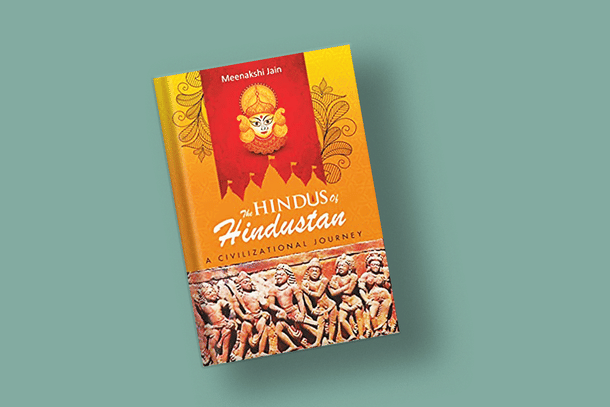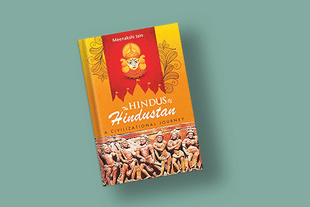Books
Why Meenakshi Jain's New Book Is A Correction Indian Historiography Desperately Needed
Aravindan Neelakandan
Mar 17, 2023, 10:53 AM | Updated 10:52 AM IST
Save & read from anywhere!
Bookmark stories for easy access on any device or the Swarajya app.


The Hindus of Hindustan: A Civilizational Journey. Meenakshi Jain. Aryan Books International. 2023. Pages 318. Rs 830.
Hindus are ancient people. They belong to the longest continuous civilisation. Naturally, one expects many books on Hindu history.
With the rare exception of Ramesh Chandra Majumdar (1888-1980), almost all historians have dealt Indian history with either a tinge of aversion or an obvious aversion for the indigenous religions of India.
This reflects in the history textbooks as well. The historiography of ancient India usually follows a pattern.
Harappan and Vedic civilisations are dealt with as unconnected.
Vedic and Upanishad period often receive a treatment like this was a natural religion of superstition and a nomadic society becoming hierarchical where priestcraft becomes all influential.
Then the Buddhist and Jain reform religions arise. These are either the proto-Protestant movements or proto-Communist movements against the priest domination.
Naturally, these religions, especially Buddhism, receives a generous treatment, not because of the innate richness of its spirituality but because it is projected as anti-Vedic and anti-Brahminical.
Then the conversion of Ashoka becomes an important dramatic event of a civilisational height achieved by ancient India. And so on and so forth.
So when the history textbook finishes with the Gupta empire and Islamist invasions begin, the student would see the invasions as ending an already degraded, inhuman, superstitious and oppressive system that has internal voices of dissent seeking liberation.
The stranglehold of such a historiography does not stop with just textbooks but also has its tentacles extending to novels and dramas, opinion pieces and political rhetoric.
So in effect, Hindus, despite being an ancient nation and a modern society, do not have a historiography that does justice to their achievements and contributions, travails and challenges.
Dr Meenakshi Jain has been fighting against this mighty civilisational offence for decades now.
She has been one mighty voice trying to heal this civilisational wound.
The textbook she wrote on Indian history in 2002, with about 91 illustrations in around 251 pages should be considered a milestone in Indian history textbook writing.
It openly challenged colonial narratives and presented a history that is justifiably positive and definitely holistic in its approach.
Unfortunately, just two years later the UPA (United Progressive Alliance) government purged the textbooks. But that did not stop her.
From the evidence of Ram temple to looking into the colonial construct of Sati as endemic to Hindu civilisation, she has been at the forefront of civilisational narrative wars, and has been doing a commendable contribution in this much-needed front.
Her latest work is the book The Hindus of Hindustan: A Civilizational Journey.
This book moves away from Marxist-colonial approach and its negative stereotypes.
Instead, in 19 chapters and 287 pages it traces through the ancient and early history of India the dynamics and evolution of its civilisational values.
Polity and material culture instead of being the core of historiography as in that of the West, become dimensions of the civilisational core. That is not an easy task.
Material culture is very important for all historians. Modern history having evolved from the West naturally has to rely on material culture rather than civilisational continuity.
After all, the West has had a chasm dividing its ancient pagan past and medieval Christian past and again the medieval Christian past and modern renaissance. With such discontinuities, material culture of the past becomes the important basis for history.
In the case of India, even though there is a civilisational continuity, the same chasms are imagined and only material culture and not civilisational continuity is given the prominence.
As a proof, when is the last time you have come across a history textbook that shows side by side a temple pond and the ‘great bath’ of Mohenjo-daro?
Dr Jain weaves a masterly narrative of both civilisational continuity through the changes, evolution and correlates of material culture through the early millennia of Hindu civilisation.
That is what makes this book important, interesting and a pioneering history text of our times.
The origin and evolution of a geocultural vision of Bharat is traced right from the Vedas to Buddhist and Jain sources to its innate understanding even by foreigners like the Greeks.
Starting from the very literary Nadi Sukta of Rig Veda to very material two Amaravati-type sculptural slabs obtained at Swat valley that ascertain the cultural bonds — between Andhra and what can be construed as the North-western frontier of the larger Indian land mass — Bharat.
In all this, the author in no diminishes the inherent diversity that evolves within India — another cultural hallmark of Hindu phenomenon.
For example, she points out the unique development that happens in the evolution of Brahmi with respect to Tamil language.
Her eloquent combination of the works of Vaiyapuri Pillai, Iravatham Mahadevan and archaeological discoveries of Kodumanal with respect to the evolution of writing system attests to her in-depth comprehension of the complexities that exist within the evolution of Hindu civilisation.
Another excellent chapter on the civilisational continuity correlated with material culture as it exists throughout history is the chapter on the ‘cult of pillar.’
Like R C Majumdar, another much neglected doyen of holistic Indian history was Vasudeva Sharan Agrawala (1904-1966). It is more than gratifying to see his understanding of the association of pillar with temple architecture.
On the authority of Prof V S Agrawala, Dr Jain enumerates five points that connect the pillar with Skambha of the Vedas. Skambha is Brahman and also the cosmic pillar and is the Yupa of the Yajna.
The concept also extends and becomes Chaitya Stambha. The tradition of Stambha worship later results in the installation of Chakra-Stambha, Garuda-Stambha etc.
The fourteenth chapter deals with ‘the Maligned lawgivers’. Unfortunately, both superficial traditionalists and equally superficial reformists give a static, almost a revealed status to Dharma Shastras.
The reality is that the Dharma Shastras were the products of their times and it is for the insightful to identify the timeless values and principles beyond the literal meaning of the text.
Dr Jain provides that historical insight into the spirit and values of Dharma Shastras. The Dharma Shastras were more direction providers than Shariat like laws.
The values of Dharm Shastra-writers more often than not accommodated diversity and a deeper spiritual unity of humanity.
Communities moved through social space. The barrier was not genetical but cultural and lost positions of the tribes could be regained according to Dharma Shastras. Clearly, the divisions were not static.
They shifted and that gave traditionalists, who adhere to the spirit of Dharma, texts to bring in what otherwise would be considered radical reforms.
This chapter is a much needed eye-opener with its relevance to present day Hindu society and the mission of Hindu unity.
Well written and concise, each sentence in this book is an outcome of a lifework of scholarship well authenticated with centuries old inscriptions in stones and texts from millennia. An outcome of a life in scholarship, this book fills a scholarly Dharmic space that is much needed in Hindu renaissance that is happening today.
Well produced by Aryan Books International, this book is a must for every Hindu house library and the libraries of the history departments throughout India.




